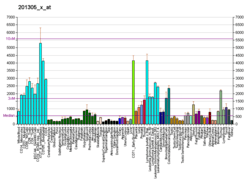ANP32B
Acidic leucine-rich nuclear phosphoprotein 32 family member B (ANP32B) also known as "acidic protein rich in leucines" (APRIL) is a protein that in humans is encoded by the ANP32B gene.[3][4][5]
APRIL is also the acronym used for an entirely different protein, TNFSF13, a member of the tumor necrosis factor superfamily whose alternative name, A PRoliferation Inducing Ligand, shares the same acronym as that for ANP32B
See also
References
- 1 2 3 GRCh38: Ensembl release 89: ENSG00000136938 - Ensembl, May 2017
- ↑ "Human PubMed Reference:".
- ↑ Zhu L, Perlaky L, Henning D, Valdez BC (Jan 1998). "Cloning and characterization of a new silver-stainable protein SSP29, a member of the LRR family". Biochem Mol Biol Int. 42 (5): 927–35. doi:10.1080/15216549700203371. PMID 9285060.
- ↑ Mencinger M, Panagopoulos I, Contreras JA, Mitelman F, Aman P (Mar 1998). "Expression analysis and chromosomal mapping of a novel human gene, APRIL, encoding an acidic protein rich in leucines". Biochim Biophys Acta. 1395 (2): 176–80. doi:10.1016/S0167-4781(97)00165-6. PMID 9473664.
- ↑ "Entrez Gene: ANP32B acidic (leucine-rich) nuclear phosphoprotein 32 family, member B".
External links
- Human ANP32B genome location and ANP32B gene details page in the UCSC Genome Browser.
Further reading
- Matilla A, Radrizzani M (2005). "The Anp32 family of proteins containing leucine-rich repeats". Cerebellum. 4 (1): 7–18. doi:10.1080/14734220410019020. PMID 15895553.
- Maruyama K, Sugano S (1994). "Oligo-capping: a simple method to replace the cap structure of eukaryotic mRNAs with oligoribonucleotides". Gene. 138 (1–2): 171–4. doi:10.1016/0378-1119(94)90802-8. PMID 8125298.
- Suzuki Y, Yoshitomo-Nakagawa K, Maruyama K, et al. (1997). "Construction and characterization of a full length-enriched and a 5'-end-enriched cDNA library". Gene. 200 (1–2): 149–56. doi:10.1016/S0378-1119(97)00411-3. PMID 9373149.
- Brennan CM, Gallouzi IE, Steitz JA (2000). "Protein ligands to HuR modulate its interaction with target mRNAs in vivo". J. Cell Biol. 151 (1): 1–14. doi:10.1083/jcb.151.1.1. PMC 2189805. PMID 11018049.
- Gallouzi IE, Steitz JA (2001). "Delineation of mRNA export pathways by the use of cell-permeable peptides". Science. 294 (5548): 1895–901. doi:10.1126/science.1064693. PMID 11729309.
- Strausberg RL, Feingold EA, Grouse LH, et al. (2003). "Generation and initial analysis of more than 15,000 full-length human and mouse cDNA sequences". Proc. Natl. Acad. Sci. U.S.A. 99 (26): 16899–903. doi:10.1073/pnas.242603899. PMC 139241. PMID 12477932.
- Jiang X, Kim HE, Shu H, et al. (2003). "Distinctive roles of PHAP proteins and prothymosin-alpha in a death regulatory pathway". Science. 299 (5604): 223–6. doi:10.1126/science.1076807. PMID 12522243.
- Humphray SJ, Oliver K, Hunt AR, et al. (2004). "DNA sequence and analysis of human chromosome 9". Nature. 429 (6990): 369–74. doi:10.1038/nature02465. PMC 2734081. PMID 15164053.
- Gerhard DS, Wagner L, Feingold EA, et al. (2004). "The status, quality, and expansion of the NIH full-length cDNA project: the Mammalian Gene Collection (MGC)". Genome Res. 14 (10B): 2121–7. doi:10.1101/gr.2596504. PMC 528928. PMID 15489334.
- Tao WA, Wollscheid B, O'Brien R, et al. (2005). "Quantitative phosphoproteome analysis using a dendrimer conjugation chemistry and tandem mass spectrometry". Nat. Methods. 2 (8): 591–8. doi:10.1038/nmeth776. PMID 16094384.
- Olsen JV, Blagoev B, Gnad F, et al. (2006). "Global, in vivo, and site-specific phosphorylation dynamics in signaling networks". Cell. 127 (3): 635–48. doi:10.1016/j.cell.2006.09.026. PMID 17081983.
This article is issued from
Wikipedia.
The text is licensed under Creative Commons - Attribution - Sharealike.
Additional terms may apply for the media files.




